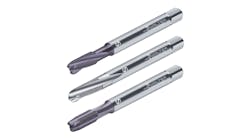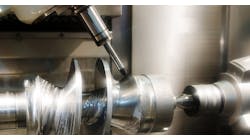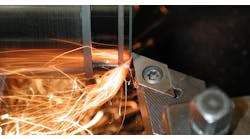Many types of tool materials, ranging from high carbon steel to ceramics and diamonds, are used as cutting tools in today’s metalworking industry. It is important to be aware that differences do exist among tool materials, what these differences are, and the correct application for each type of material.
The various tool manufacturers assign many names and numbers to their products. While many of these names and numbers may appear to be similar, the applications of these tool materials may be entirely different. In most cases, the tool manufacturers will provide tools made of the proper material for each given application. In some particular applications, a premium or higher priced material will be justified.
This does not mean that the most expensive tool is always the best tool. Cutting tool users can’t afford to ignore the constant changes and advancements that are being made in the field of tool material technology. When a tool change is needed or anticipated, a performance comparison should be made before selecting the tool for the job. The optimum tool is not necessarily the least expensive or the most expensive, and it is not always the same tool that was used for the job last time. The best tool is the one that has been carefully chosen to get the job done quickly, efficiently, and economically.
A cutting tool must have the following characteristics in order to produce good quality and economical parts:
Hardness — harness and strength of the cutting tool must be maintained at elevated temperatures, also called hot hardness (Figure 1.1)
Toughness — toughness of cutting tools is needed so that tools don’t chip or fracture, especially during interrupted cutting operations.
Wear Resistance — wear resistance means the attainment of acceptable tool life before tools need to be replaced.
The materials from which cutting tools are made are all characteristically hard and strong. There is a wide range of tool materials available for machining operations, and the general classification and use of these materials are of interest here.
Tool Steels and Cast Alloys
Plain carbon tool steel is the oldest of the tool materials dating back hundreds of years. In simple terms, it is a high-carbon steel, which contains about 1.05% carbon. This high carbon content allows the steel to be hardened, offering greater resistance to abrasive wear. Plain high carbon steel served its purpose well for many years. However, because it is quickly over tempered (softened) at relatively low cutting temperatures (300 to 500°F), it is now rarely used as cutting tool material except in files, saw blades, chisels, etc. The use of plain high carbon steel is limited to low heat applications.
High Speed Tool Steel. The need for tool materials that could withstand increased cutting speeds and temperatures led to the development of high-speed tool steels (HSS). The major difference between HSS and plain high carbon steel is the addition of alloying elements to harden and strengthen the steel and make it more resistant to heat (hot hardness).
Some of the most commonly used alloying elements are manganese, chromium, tungsten, vanadium, molybdenum, cobalt, and niobium. While each of these elements will add certain specific desirable characteristics, it can be generally state that they add deep hardening capability, high hot hardness, resistance to abrasive wear, and strength, to HSS. These characteristics allow relatively higher machining speeds and improved performance over plain high carbon steel.
The most common HSS used primarily as cutting tools are divided into the M and T series. The M series represents tool steels of molybdenum type and the T series represents Tungsten. Although there seems to be a great deal of similarly among these HSS, each one serves a specific purpose and offers significant benefits in its special application.
An important point to remember is that none of the alloying elements for either series of HSS is in abundant supply and the cost of these elements is skyrocketing. In addition, U.S. manufacturers must rely on foreign countries for supply of these very important elements.
Some of the HSS are now available in powdered metal (PM) form. The difference between powdered and conventional metals is in the method by which they are made. The majority of conventional HSS is poured into an ingot, and then, either hot or cold, worked to the desired shape. Powdered metal is exactly as its name indicates. Basically the same elements that are used in conventional high-speed steel are prepared in a very fine powdered form. These powdered elements are carefully blended together, pressed into a die under extremely high pressure, and then sintered in an atmospherically controlled furnace. (The PM method of manufacturing cutting tools is explained later in this chapter.)
HSS Surface Treatment. Many surface treatments have been developed in an attempt to extend tool life, reduce power consumption, and to control other factors that affect operating conditions and costs. Some of these treatments have been used for many years and have proven to have some value. For example, the black oxide coatings that commonly appear on drills and taps are of value as a deterrent to build-up on the tool. The black oxide is basically ‘dirty’ surface that discourages the build-up of work material.
One of the more recent developments in coatings for HHS is titanium nitride by the physical vapor deposition (PVD) method. Titanium nitride is deposited on the tool surface in one of several different types of furnace at relatively low temperature, which does not significantly affect the heat treatment (hardness) of the tool being coated. This coating is known to extend the life of a cutting tool significantly or to allow the tool to be used at higher operating speeds. Tool life can be extended by as much as three times, or operating speeds can be increased up to 50%.
Cast Alloys. The alloying elements in HSS - principally cobalt, chromium, and tungsten - improve the cutting properties sufficiently, that metallurgical researchers developed the cast alloys, a family of materials without iron.
A typical composition for this class was 45% cobalt, 32% chromium, 21% tungsten, and 2% carbon. The purpose was to obtain a cutting tool with hot hardness superior to HSS.
When applying cast alloy tools, their brittleness should be kept in mind and sufficient support should be provided at all times. Cast alloys provide high abrasion resistance and are thus useful for cutting scaly materials or those with hard inclusions.
Cemented Tungsten Carbide
Henri Moissan discovered tungsten carbide in 1893 during a search for method of making artificial diamonds. Charging sugar and tungsten oxide, he melted tungsten sub-carbide in an arc furnace. The carbonized sugar reduced the oxide and carburized the tungsten Moissan recorded that the tungsten carbide was extremely hard, approaching the hardness of diamond and exceeding that of sapphire. It was more than 16x as heavy as water. The material proved to be extremely brittle and seriously limited its industrial use.
Commercial tungsten carbide with 6% cobalt binder was first produced and marketed in Germany in 1926. Production of the same carbide began in the U.S. in 1928 and in Canada in 1930.
At this time, hard carbides consisted of the basic tungsten carbide system with cobalt binders. These carbides exhibited superior performance in the machining of cast iron, nonferrous, and non-metallic materials, but were disappointed when used for the machining of steel.
Most of the subsequent developments in the hard carbides have been modifications of the original patents, principally involving replacement of part or all of the tungsten carbide with other carbides, especially titanium carbide and/or tantalum carbide. This led to the development of the modern multi-carbide cutting tool materials permitting the high speed machining of steel.
A new phenomenon was introduced with the development of the cemented carbides, again making higher speeds possible. Previous cutting tool materials, products of molten metallurgy, depended largely upon heat treatment for their properties and these properties could, in turn, be destroyed by further heat temperatures, these products of molten metallurgy failed.
A different set of conditions exist with the cemented carbides. The hardness of the carbide is greater than the of most other tool materials at room temperature and it has the ability to retain its hardness at elevated temperatures to a greater degree, so that greater speeds can be adequately supported.
Manufacture of Carbide Products
The term “tungsten carbide” describes a comprehensive family of hard carbide compositions used for metal cutting tools, dies of various types, and wear parts. In general, these materials are composed of the carbides of tungsten, titanium, tantalum, or some combination of these, sintered or cemented in a matrix binder, usually cobalt.
Blending. The first operation after reduction of the tungsten metal powder is the milling of tungsten and carbon prior to the carburizing operation. Here, 94 parts by weight of tungsten and six parts by weight of carbon - usually added in the form of lampblack - are blended together in a rotating mixer or ball mill. This operation must be performed under carefully controlled conditions in order to insure optimum dispersion of the carbon in the tungsten. Carbide blending equipment - better known as a ball mill - is shown in figure 1.2.
In order to provide the necessary strength, a binding agent, usually cobalt is added to the tungsten in powder form and these two are ball milled together for a period of several days, to form a very intimate mixture. Careful control of conditions, including time, must be exercised to obtain a uniform, homogeneous product. (See figure 1.3)
Compacting. The most common compacting method for grade powders involves the use of a die, made to the shape of the eventual product desired. The size of the die must be greater than the final product size to allow for dimensional shrinkage that takes place in the final sintering operation. These dies are expensive, and usually made with tungsten carbide liners. Therefore, sufficient number of the final product (compacts) are required, to justify the expense involved in manufacturing a specific die. Carbide compacting equipment - better known as a pill press - is shown in figure 1.4, and various pill pressed carbide parts are shown in figure 1.5.
If the quantities are not high, a larger briquette, or billet, may be pressed. This billet may then be cut up (usually after pre-sintering) into smaller units and shaped or preformed to the required configuration, and again, allowance must be made to provide for shrinkage. Ordinarily pressures used in these cold compacting operations are in the neighborhood of 30,000 PSI. Various carbide-preformed parts are shown in figure 1.6.
A second compacting method is the hot pressing of grade powders in graphite dies at the sintering temperature. After cooling, the part has attained full hardness. Because the graphite dies are expendable, this system is generally used only when the part to be produced it too large for cold pressing and sintering.
A third compacting method, usually used for large pieces, is isostatic pressing. Powders are placed in a closed, flexible container that is then suspended in a liquid in a closed pressure vessel. Pressure in the liquid is built up to the point where the powders become properly compacted. This system is advantageous for pressing large pieces, because the pressure acting on the powders operates equally from all directions, resulting in a compact of uniform pressed density.
Sintering. A cobalt compact is heated in a hydrogen atmosphere or vacuum furnace in temperatures ranging from 2,500 to 2,900°F, depending on the composition. Both time and temperature are carefully adjusted in combination, to effect optimum control over properties and geometry. The compact will shrink approximately 16% on linear dimensions, or 40% in volume. The exact amount of shrinkage depends on several factors, including particle size of the powders, and the composition of the grade. Control of the size and shape is most important and is least predictable during the cooling cycle. This is particularly true with those grades of cemented carbides with higher cobalt contents.
With cobalt having a lesser density than tungsten, it occupies a greater part of the volume than would be indicated by the rated cobalt content of the grade. And, because cobalt contents are generally a much higher percentage of the mass in liquid phase, extreme care is required to control and predict with accuracy the magnitude and direction of shrinkage. Figure 1.7 shows carbide parts being loaded into a sintering furnace, and a more detailed schematic diagram of the cemented tungsten carbide manufacturing process is shown in figure 1.8.
Classification of Carbide Tools
Cemented carbide products are classified into three major categories:
• Wear Grades, used primarily in dies, machine and tool guides, and in everyday items such as line guides on fishing rods and reels. Used anywhere good wear resistance is required.
• Impact Grades, also used for dies, particularly for stamping and forming, and in tools such as mining drill heads.
• Cutting Tool Grades, the cutting tool grades of cemented carbides are divided into two groups, depending on their primary application. If the carbide is intended for use on cast iron that is a nonductile material, it is graded as a cast iron carbide. If it is to be used to cut steel, a ductile material, it is graded as a steel grade carbide.
Cast iron carbides must be more resistant to abrasive wear. Steel carbides require more resistance to cratering and heat. The tool wear characteristics of various metals are different, thereby requiring different tool properties. The high abrasiveness of cast iron causes mainly edge wear to the tool. The long chip of steel, which flows across the tool at normally higher cutting speeds, causes.
George Schneider, Jr., is the author of Cutting Tool Applications, a handbook to machine tool materials, principles, and designs. He is the Professor Emeritus of Engineering Technology at Lawrence Technological University, and former Chairman of the Detroit Chapter of the Society of Manufacturing Engineers.








